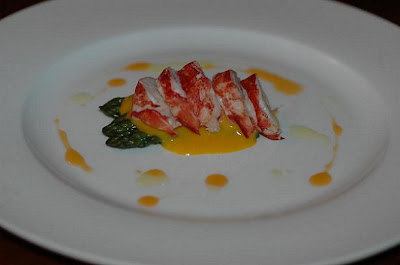There's always a danger with lobster that you drown its delicate flavour with sauces and accompaniments. This frequently leads to timid options, pairing the lobster with Hollandaise sauce or with a little citrus sweetened with cream. When I was offered a pair of lobsters to take home, I was determined that I would try something more adventurous. I'd been thinking about making a mango-chilli mousse for quite a while and this was the perfect time. It worked well - despite the potency of the mousse, the flavour of the lobster was maintained. And there was an unexpected bonus because I made enough mousse to allow me to reconstitute the leftovers later... but that's another story. Ingredients (4 portions) For the meat and veg: 2 medium sized lobsters 20 spears of baby asparagus salt black pepper lemon-infused olive oil For the mousse:* 1/4 cup lime juice (2 large or 4 small limes) 2 lbs ripe mango (or tinned pure mango pulp) 1 red chilli, very finely chopped** 1/4 cup sugar*** 1 egg white 4 leaves unflavoured gelatin 1/4 cup double cream pinch of salt * Note that the quantities listed here make perhaps 20 portions of mousse and are ideal if you want to put some away to use later, as I did. My photographs show these quantities. It would be very difficult to make mousse in the quantity required just for this recipe, but you can certainly scale down. ** With the chilli you need to experiment and use a type and quantity suitable for your personal taste. I used one small Scotch Bonnet, which gives a unique flavour as well as a strong pungency. Most important is to chop it very finely, so you don't end up with hot spots in the mousse! *** Add less if your mango pulp is sweetened, a little more if using fresh fruit. Method |
 | Halve the limes and squeeze into a cup. |
| Now add the gelatin leaves to 1/4 cup of hot water in a bowl and allow the gelatin to dissolve. |  |
 | Put the mango pulp into a bowl, stir in the sugar, the gelatin and the finely chopped chilli. |
| Beat the cream to soft peaks. |  |
 | And beat the egg white to firm peaks. |
| Now fold the cream into the beaten egg white. |  |
 | And then gently fold the cream and egg into the mango, sugar and chilli mixture. |
| You need patience here - keep folding gently until thoroughly blended. Avoid the temptation to use a blender at this stage, as this will knock out the air you've just add to the cream and albumen. |  |
 | Now chill in a fridge for two hours or more, or put in the freezer for 30 minutes or so (don't allow it to freeze!) |
 | As with crustaceans such as prawns, the lobster turns bright pink almost instantly in boiling water. Langoustines are an exception to this, as they are naturally pink. |
| Rest the cooked lobsters and allow to fully cool. |  |
 | At the end of the day there's no substitute for washing your hands and getting stuck in! |









